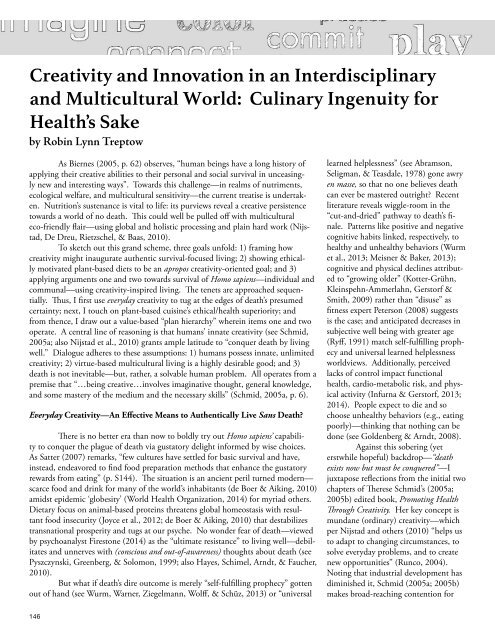Torrance Journal for Applied Creativity
TorranceJournal_V1
TorranceJournal_V1
You also want an ePaper? Increase the reach of your titles
YUMPU automatically turns print PDFs into web optimized ePapers that Google loves.
<strong>Creativity</strong> and Innovation in an Interdisciplinary<br />
and Multicultural World: Culinary Ingenuity <strong>for</strong><br />
Health’s Sake<br />
by Robin Lynn Treptow<br />
As Biernes (2005, p. 62) observes, “human beings have a long history of<br />
applying their creative abilities to their personal and social survival in unceasingly<br />
new and interesting ways”. Towards this challenge—in realms of nutriments,<br />
ecological welfare, and multicultural sensitivity—the current treatise is undertaken.<br />
Nutrition’s sustenance is vital to life: its purviews reveal a creative persistence<br />
towards a world of no death. This could well be pulled off with multicultural<br />
eco-friendly flair—using global and holistic processing and plain hard work (Nijstad,<br />
De Dreu, Rietzschel, & Baas, 2010).<br />
To sketch out this grand scheme, three goals unfold: 1) framing how<br />
creativity might inaugurate authentic survival-focused living; 2) showing ethically<br />
motivated plant-based diets to be an apropos creativity-oriented goal; and 3)<br />
applying arguments one and two towards survival of Homo sapiens—individual and<br />
communal—using creativity-inspired living. The tenets are approached sequentially.<br />
Thus, I first use everyday creativity to tug at the edges of death’s presumed<br />
certainty; next, I touch on plant-based cuisine’s ethical/health superiority; and<br />
from thence, I draw out a value-based “plan hierarchy” wherein items one and two<br />
operate. A central line of reasoning is that humans’ innate creativity (see Schmid,<br />
2005a; also Nijstad et al., 2010) grants ample latitude to “conquer death by living<br />
well.” Dialogue adheres to these assumptions: 1) humans possess innate, unlimited<br />
creativity; 2) virtue-based multicultural living is a highly desirable good; and 3)<br />
death is not inevitable—but, rather, a solvable human problem. All operates from a<br />
premise that “…being creative…involves imaginative thought, general knowledge,<br />
and some mastery of the medium and the necessary skills” (Schmid, 2005a, p. 6).<br />
Everyday <strong>Creativity</strong>—An Effective Means to Authentically Live Sans Death?<br />
There is no better era than now to boldly try out Homo sapiens’ capability<br />
to conquer the plague of death via gustatory delight in<strong>for</strong>med by wise choices.<br />
As Satter (2007) remarks, “few cultures have settled <strong>for</strong> basic survival and have,<br />
instead, endeavored to find food preparation methods that enhance the gustatory<br />
rewards from eating” (p. S144). The situation is an ancient peril turned modern—<br />
scarce food and drink <strong>for</strong> many of the world’s inhabitants (de Boer & Aiking, 2010)<br />
amidst epidemic ‘globesity’ (World Health Organization, 2014) <strong>for</strong> myriad others.<br />
Dietary focus on animal-based proteins threatens global homeostasis with resultant<br />
food insecurity (Joyce et al., 2012; de Boer & Aiking, 2010) that destabilizes<br />
transnational prosperity and tugs at our psyche. No wonder fear of death—viewed<br />
by psychoanalyst Firestone (2014) as the “ultimate resistance” to living well—debilitates<br />
and unnerves with (conscious and out-of-awareness) thoughts about death (see<br />
Pyszczynski, Greenberg, & Solomon, 1999; also Hayes, Schimel, Arndt, & Faucher,<br />
2010).<br />
But what if death’s dire outcome is merely “self-fulfilling prophecy” gotten<br />
out of hand (see Wurm, Warner, Ziegelmann, Wolff, & Schüz, 2013) or “universal<br />
learned helplessness” (see Abramson,<br />
Seligman, & Teasdale, 1978) gone awry<br />
en masse, so that no one believes death<br />
can ever be mastered outright? Recent<br />
literature reveals wiggle-room in the<br />
“cut-and-dried” pathway to death’s finale.<br />
Patterns like positive and negative<br />
cognitive habits linked, respectively, to<br />
healthy and unhealthy behaviors (Wurm<br />
et al., 2013; Meisner & Baker, 2013);<br />
cognitive and physical declines attributed<br />
to “growing older” (Kotter-Grühn,<br />
Kleinspehn-Ammerlahn, Gerstorf &<br />
Smith, 2009) rather than “disuse” as<br />
fitness expert Peterson (2008) suggests<br />
is the case; and anticipated decreases in<br />
subjective well being with greater age<br />
(Ryff, 1991) match self-fulfilling prophecy<br />
and universal learned helplessness<br />
worldviews. Additionally, perceived<br />
lacks of control impact functional<br />
health, cardio-metabolic risk, and physical<br />
activity (Infurna & Gerstorf, 2013;<br />
2014). People expect to die and so<br />
choose unhealthy behaviors (e.g., eating<br />
poorly)—thinking that nothing can be<br />
done (see Goldenberg & Arndt, 2008).<br />
Against this sobering (yet<br />
erstwhile hopeful) backdrop—“death<br />
exists now but must be conquered”—I<br />
juxtapose reflections from the initial two<br />
chapters of Therese Schmid’s (2005a;<br />
2005b) edited book, Promoting Health<br />
Through <strong>Creativity</strong>. Her key concept is<br />
mundane (ordinary) creativity—which<br />
per Nijstad and others (2010) “helps us<br />
to adapt to changing circumstances, to<br />
solve everyday problems, and to create<br />
new opportunities” (Runco, 2004).<br />
Noting that industrial development has<br />
diminished it, Schmid (2005a; 2005b)<br />
makes broad-reaching contention <strong>for</strong><br />
146


